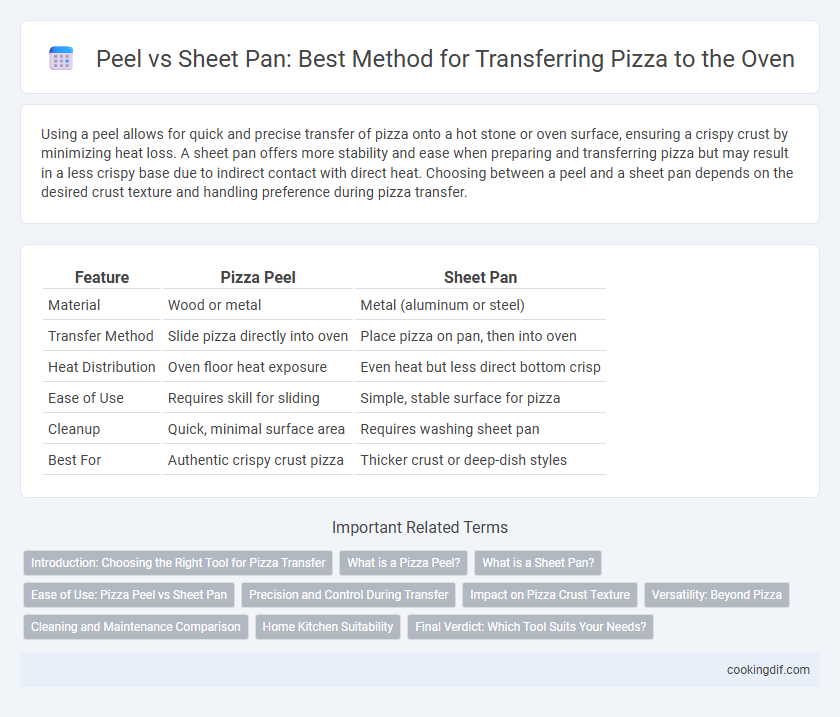Using a peel allows for quick and precise transfer of pizza onto a hot stone or oven surface, ensuring a crispy crust by minimizing heat loss. A sheet pan offers more stability and ease when preparing and transferring pizza but may result in a less crispy base due to indirect contact with direct heat. Choosing between a peel and a sheet pan depends on the desired crust texture and handling preference during pizza transfer.
Table of Comparison
| Feature | Pizza Peel | Sheet Pan |
|---|---|---|
| Material | Wood or metal | Metal (aluminum or steel) |
| Transfer Method | Slide pizza directly into oven | Place pizza on pan, then into oven |
| Heat Distribution | Oven floor heat exposure | Even heat but less direct bottom crisp |
| Ease of Use | Requires skill for sliding | Simple, stable surface for pizza |
| Cleanup | Quick, minimal surface area | Requires washing sheet pan |
| Best For | Authentic crispy crust pizza | Thicker crust or deep-dish styles |
Introduction: Choosing the Right Tool for Pizza Transfer
A pizza peel offers precise control with its thin, flat surface, allowing easy sliding of dough onto hot stones or ovens, essential for achieving a perfect crust. In contrast, a sheet pan provides stability and simplicity, making it suitable for transferring thicker or less flexible pizzas without risk of deformation. Selecting between a peel and a sheet pan depends on the type of pizza, baking method, and desired handling convenience.
What is a Pizza Peel?
A pizza peel is a wide, flat tool typically made of wood or metal used to transfer pizzas in and out of an oven with ease. Its thin, sturdy surface allows for quick sliding under a pizza dough, preventing toppings from shifting while ensuring safe handling at high temperatures. Compared to a sheet pan, a peel offers more precise control and faster transfers when baking stone-fired or thin-crust pizzas.
What is a Sheet Pan?
A sheet pan is a flat, rectangular metal baking tray commonly used in kitchens for baking and roasting various foods, including pizza. It typically features low edges that allow for even heat distribution and easy transfer of dough or toppings in and out of the oven. Unlike a pizza peel, a sheet pan holds the pizza securely, preventing toppings from sliding during transfer but may not offer the same quick sliding capability.
Ease of Use: Pizza Peel vs Sheet Pan
A pizza peel offers superior ease of use for transferring pizzas directly onto a hot stone or oven surface, minimizing the risk of toppings sliding off during transfer. Sheet pans provide a stable platform for assembling and transporting pizzas but may require additional effort to slide the pizza off onto the baking surface. Professional pizzaiolos often prefer peels for their precision and speed, while home cooks may find sheet pans more convenient for preparation and baking.
Precision and Control During Transfer
A pizza peel offers superior precision and control during transfer, allowing for smooth sliding of dough onto the oven surface without disturbing toppings. Its thin, rigid structure facilitates quick release and accurate placement compared to a sheet pan, which can be less maneuverable and may cause the dough to shift. Pizza peels are essential tools for achieving perfect crust texture and even baking in professional and home kitchens.
Impact on Pizza Crust Texture
Using a pizza peel for transferring dough onto a hot stone promotes a crispier, more evenly baked crust due to direct heat exposure and better airflow. In contrast, a sheet pan often results in a softer, thicker crust as it limits heat circulation and creates a barrier between the dough and the heat source. The choice between peel and sheet pan directly impacts the pizza crust texture, with peels favoring artisan-style crispness and sheet pans yielding a chewier bite.
Versatility: Beyond Pizza
A pizza peel offers unmatched versatility for transferring not only pizzas but also bread, calzones, and pastries directly in and out of high-heat ovens, ensuring precise placement without disturbing delicate dough. Sheet pans provide a multifunctional option ideal for roasting vegetables, baking cookies, and preparing sheet-pan meals, making them indispensable in everyday cooking beyond pizza. Choosing between a peel and a sheet pan depends on whether you prioritize specialized pizza handling or broader kitchen applications.
Cleaning and Maintenance Comparison
Peel and sheet pans differ significantly in cleaning and maintenance; wooden pizza peels require regular oiling to prevent cracking, while metal peels are easy to clean but prone to dents. Sheet pans are typically dishwasher safe and more resistant to wear, offering a hassle-free cleaning experience. The smooth surface of sheet pans minimizes dough sticking, reducing residue buildup and simplifying upkeep compared to textured peels.
Home Kitchen Suitability
A pizza peel offers greater control and precision when transferring dough to and from a hot stone, making it ideal for home kitchens focused on authentic, crispy crusts. Sheet pans provide a more stable surface for assembling and baking pizzas in conventional ovens, suited for users prioritizing convenience and ease of use. Choosing between the two depends on oven type and desired pizza texture, with peels favoring artisan styles and sheet pans supporting everyday homemade pizzas.
Final Verdict: Which Tool Suits Your Needs?
A pizza peel offers precise control and ease of sliding pizzas into a hot oven, ideal for those frequently baking thin-crust or Neapolitan-style pizzas at high temperatures. Sheet pans excel in versatility and stability, perfect for thicker crusts or topping-heavy pizzas, and double as baking trays for various dishes. Choosing between a peel and a sheet pan depends on your pizza style preference, oven type, and cooking frequency, ensuring optimal results tailored to your kitchen setup.
Peel vs Sheet pan for pizza transfer Infographic

 cookingdif.com
cookingdif.com